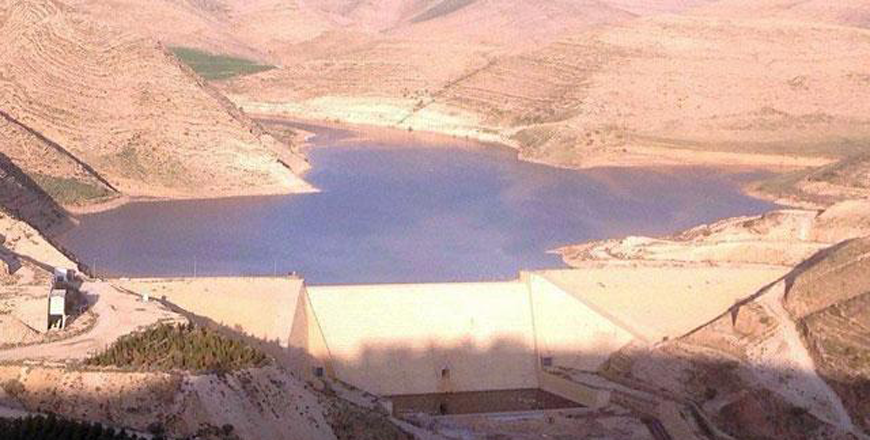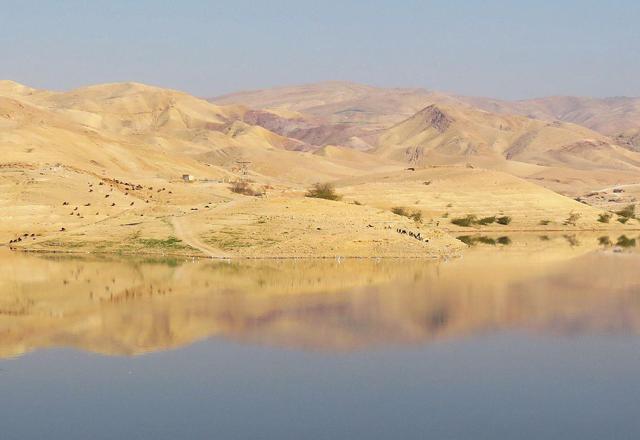You are here
Overuse of water resources exacerbate depletion of groundwater reserves — experts
By Sara Faqir - Dec 16,2023 - Last updated at Dec 16,2023

A general view of the Waleh Dam on the northern borders with Syria (JT file photo)
AMMAN — Jordan grapples with water scarcity, which is interconnected between rainfall and groundwater levels. The dynamics of how rainfall shapes groundwater levels across the Kingdom influences the availability of water, according to experts.
Jordan is ranked among the world’s most water-scarce countries in terms of renewable freshwater, with approximately 61 cubic metres per capita in 2021. The factors of climate change and overuse of water resources have exacerbated the depletion of groundwater resources, according to the National Water Strategy 2023-2040.
The Water Ministry Spokesperson Omar Salameh told The Jordan Times on Thursday that, concerning the amount of rainfall since the beginning of the wet season in all governorates of the Kingdom until the morning of Thursday, December 14, 2023, the long-term annual average has increased to 28.6 per cent, compared with 17.1 per cent for the same period last year.
Salameh said that rainfall fluctuations have an adverse effect in most cases on groundwater levels, suggesting the National Water Carrier Project as a key solution, which, he added, is aimed to provide approximately 300 million cubic metres of desalinated water annually, to meet the water needs of four million individuals across the Kingdom.
This project aims to utilise sea water instead of relying on sources such as groundwater aquifers, he said.
Qasem Abdelal, dean of German Jordanian University’s faculty of natural resources engineering and management, said, “Groundwater basins are either renewable or non-renewable. Renewable groundwater basins are those that receive regular deposits such as rainfall allowing for sustainable supply, while non-renewable groundwater basins are fixed in deposit and, once depleted, they cannot be replenished.”
“In general groundwater can be refilled from rainfall that then flows in valleys towards low points, eventually infiltrating soil. Certain soil types, such as sand, have the capacity to drain water fast, while other types such as clay are far slower,” the professor said.
Concerning the challenges in maintaining sustainable groundwater levels amid changing rainfall patterns, Abdelal said, “Over abstraction from the groundwater sources has always been a challenge, the deficit in the county’s water needs has historically been compensated by over abstraction of groundwater, some aquifers are non-renewable and thus do not get replenished and water level keeps decreasing, abstraction from renewable aquifers need to be less than or equal groundwater recharge rates to ensure stable groundwater levels.”
There are innovative water engineering solutions implemented to enhance groundwater recharge in response to variable rainfall, he said, “One of the solutions is rainwater harvesting excavations, for groundwater recharge, which is a common practice implemented by the Ministry of Water and Irrigation in different locations within the Kingdom.”
“Some of the initiatives performed better than others depending on the soil type, and the quality of the run-off water.”
Long-term changes in groundwater levels in Jordan significantly correlate with rainfall fluctuations, according to Sakher Al Nsour, former head of the Jordanian Geologists Syndicate.
He said that prolonged droughts negatively impact groundwater levels, as large quantities are extracted without adequate replenishment, causing a significant decline in groundwater levels over these years.
Nsour said that precipitation is distributed among evaporation and surface runoff, while a small percentage percolates through soil and rocks to replenish groundwater.
“Generally, increased precipitation boosts groundwater deposits, yet this also depends on rainfall patterns. For instance, when large amounts of rain fall in a short period, most of the precipitation flows into valleys as surface runoff,” he explained.
Nsour noted that regions with high precipitation, mostly located along the western highlands, are considered crucial for refilling groundwater reserves. “This is not only due to the abundance of rainfall but also because of the specific rock types exposed in these areas, characterised by high porosity and permeability.”
“In some regions, the slope in these areas can be steep or very steep, and this can cause rainwater to run off quickly instead of soaking into the ground. This diminishes the ability of these areas to replenish groundwater. However, the water flowing from these sources either ends up in dams or in the Jordan Valley and Wadi Arabah.”
Related Articles
AMMAN — Experts from The Netherlands, Jordan and the US teamed up to find possible solutions for climate change adaptation, and options to i
AMMAN — The climate change directly affects monuments in different parts of the world.
AMMAN — Water pumping from the Kingdom’s main aquifers increased by 32 per cent between 2017 and 2018, according to a new study released on













